2023 TOYOTA PRIUS weight
[x] Cancel search: weightPage 57 of 770
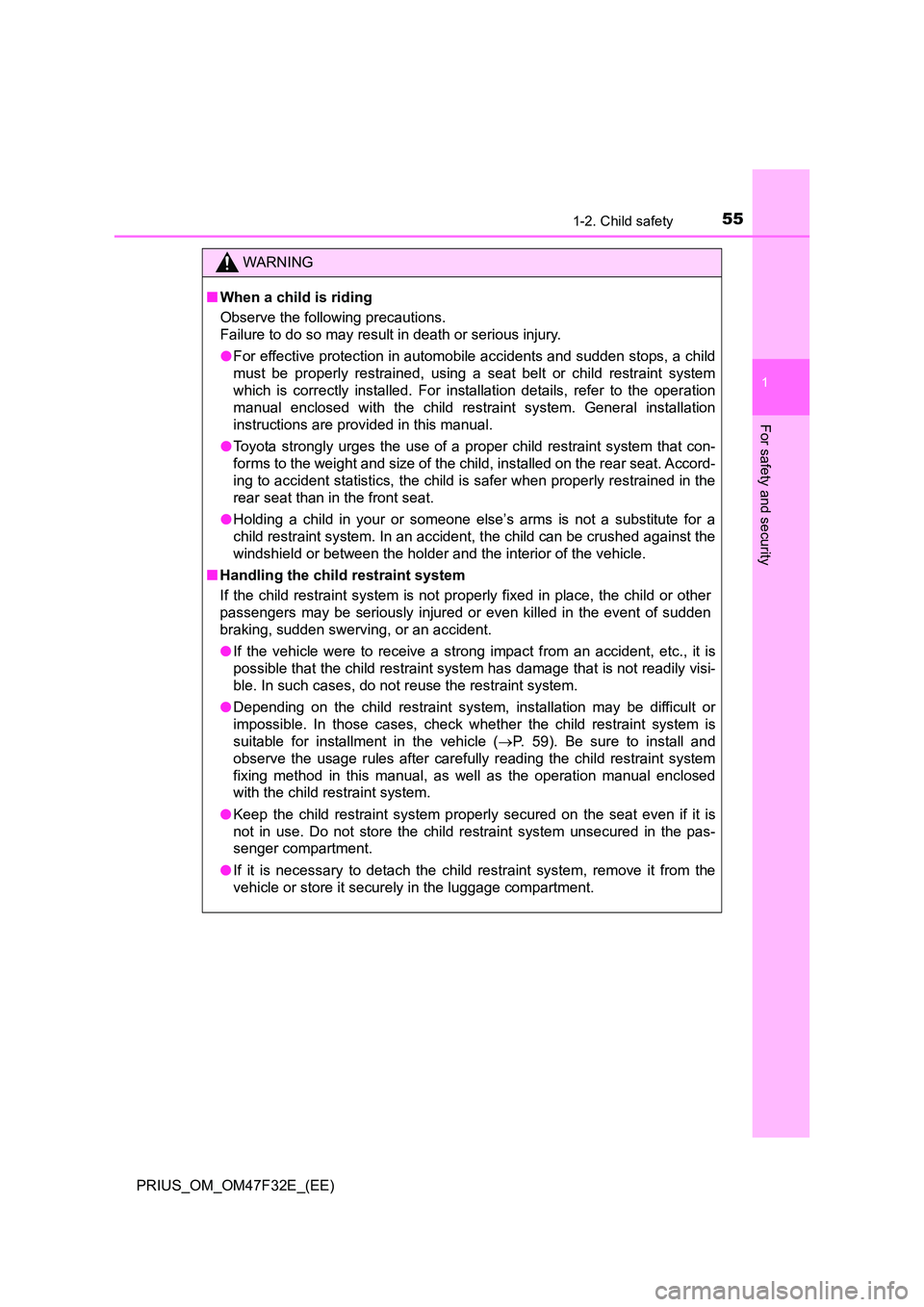
551-2. Child safety
1
PRIUS_OM_OM47F32E_(EE)
For safety and security
WARNING
■When a child is riding
Observe the following precautions.
Failure to do so may result in death or serious injury.
● For effective protection in automobile accidents and sudden stops, a child
must be properly restrained, using a seat belt or child restraint system
which is correctly installed. For inst allation details, refer to the operation
manual enclosed with the child restraint system. General installation
instructions are provided in this manual.
● Toyota strongly urges the use of a proper child restraint system that con-
forms to the weight and size of the child, installed on the rear seat. Accord-
ing to accident statistics, the child is safer when properly restrained in the
rear seat than in the front seat.
● Holding a child in your or someone else’s arms is not a substitute for a
child restraint system. In an accident, the child can be crushed against the
windshield or between the holder and the interior of the vehicle.
■ Handling the child restraint system
If the child restraint system is not properly fixed in place, the child or other
passengers may be seriously injured or even killed in the event of sudden
braking, sudden swerving, or an accident.
● If the vehicle were to receive a strong impact from an accident, etc., it is
possible that the child restraint system has damage that is not readily visi-
ble. In such cases, do not reuse the restraint system.
● Depending on the child restraint system, installation may be difficult or
impossible. In those cases, check whether the child restraint system is
suitable for installment in the vehicle ( P. 59). Be sure to install and
observe the usage rules after carefully reading the child restraint system
fixing method in this manual, as well as the operation manual enclosed
with the child restraint system.
● Keep the child restraint system properly secured on the seat even if it is
not in use. Do not store the child restraint system unsecured in the pas-
senger compartment.
● If it is necessary to detach the child restraint system, remove it from the
vehicle or store it securely in the luggage compartment.
Page 61 of 770

591-2. Child safety
1
PRIUS_OM_OM47F32E_(EE)
For safety and security
■Child restraint system compatibility for each seating position
Compatibility of each seating position with child restraint systems
( P. 61) displays the type of child restraint systems that can be
used and possible seating positions for installation using symbols.
Also, the recommended child restraint system that is suitable for
your child can be selected.
Otherwise, check [Recommended child restraint systems informa-
tion] for recommended child restraint systems. ( P. 6 6 )
Check the selected child restraint system together with the follow-
ing [Before confirming the compatibility of each seating position
with child restraint systems].
■Before confirming the compatibility of each seating position
with child restraint systems
Checking the child restraint system standards.
Use a child restraint system that conforms to UN(ECE) R44*1 or
UN(ECE) R129*1, 2.
The following approval mark is displayed on child restraint sys-
tems which are conformed.
Check for an approval mark attached to the child restraint sys-
tem.
Example of the displayed
regulation number
UN(ECE) R44 approval
mark*3
The weight range of the
child who is applicable for
an UN(ECE) R44 approval
mark is indicated.
UN(ECE) R129 approval
mark*3
The height range of the
child who is applicable as
well as available weights
for an UN(ECE) R129
approval mark is indicated.
Child restraint system compatibility for each seating position
1
1
2
Page 67 of 770
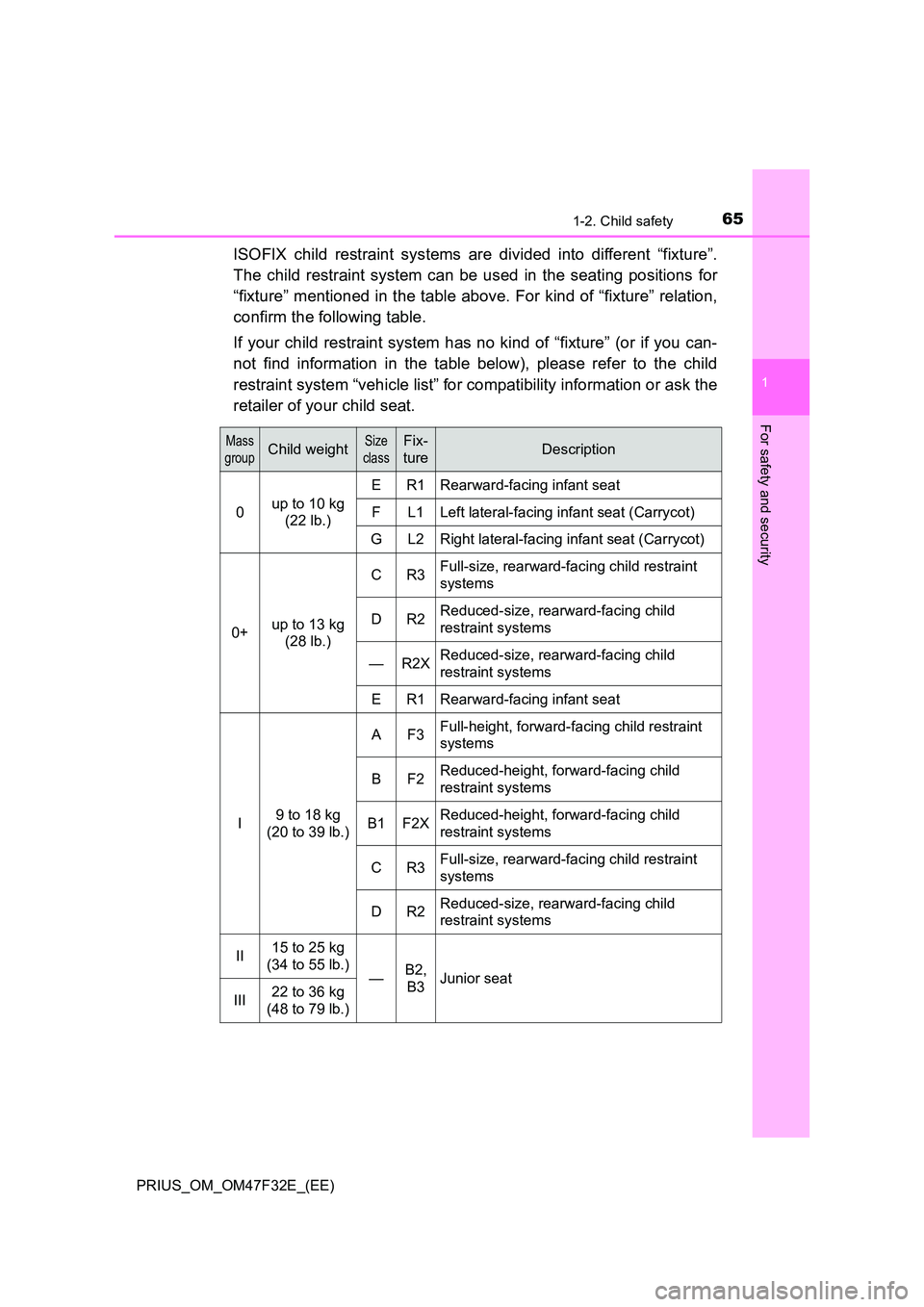
651-2. Child safety
1
PRIUS_OM_OM47F32E_(EE)
For safety and security
ISOFIX child restraint systems are divided into different “fixture”.
The child restraint system can be used in the seating positions for
“fixture” mentioned in the table above. For kind of “fixture” relation,
confirm the following table.
If your child restraint system has no kind of “fixture” (or if you can-
not find information in the table below), please refer to the child
restraint system “vehicle list” for compatibility information or ask the
retailer of your child seat.
Mass
groupChild weightSize
class
Fix-
tureDescription
0up to 10 kg
(22 lb.)
ER1Rearward-facing infant seat
FL1Left lateral-facing infant seat (Carrycot)
GL2Right lateral-facing infant seat (Carrycot)
0+up to 13 kg
(28 lb.)
CR3Full-size, rearward-facing child restraint
systems
DR2Reduced-size, rearward-facing child
restraint systems
—R2XReduced-size, rearward-facing child
restraint systems
ER1Rearward-facing infant seat
I9 to 18 kg
(20 to 39 lb.)
AF3Full-height, forward-facing child restraint
systems
BF2Reduced-height, forward-facing child
restraint systems
B1F2XReduced-height, forward-facing child
restraint systems
CR3Full-size, rearward-facing child restraint
systems
DR2Reduced-size, rearward-facing child
restraint systems
II15 to 25 kg
(34 to 55 lb.)—B2,
B3Junior seat
III22 to 36 kg
(48 to 79 lb.)
Page 236 of 770

2344-1. Before driving
PRIUS_OM_OM47F32E_(EE)
◆Weight limits
Check the allowable towing capacity, GVM (Gross Vehicle Mass),
MPAC (Maximum Permissible Axle Capacity), and permissible
drawbar load before towing. (P. 654)
◆Towing hitch/bracket
Toyota recommends the use of the Toyota hitch/bracket for your
vehicle. Other products of a suitable nature and comparable quality
may also be used.
For vehicles where the towing device blocks any of the lights or
license plate, the following shall be observed:
●Do not use towing devices that cannot be easily removed or
repositioned.
●Towing devices must be removed or repositioned when not in
use.
Please consult at any authorized dealer or repairer, or another duly
qualified and equipped professional when installing trailer lights, as
incorrect installation may cause damage to the vehicle’s lights. Please
take care to comply with your state’s laws when installing trailer lights.
■Total trailer weight and permissible drawbar load
Total trailer weight
Weight of the trailer itself plus
the trailer load should be within
the maximum towing capacity.
Exceeding this weight is danger-
ous. (P. 654)
When towing a trailer, use a fric-
tion coupler or friction stabilizer
(sway control device).
Permissible drawbar load
Allocate the trailer load so that the drawbar load is greater than 25 kg
(55.1 lb.) or 4% of the towing capacity. Do not let the drawbar load
exceed the indicated weight. (P. 654)
Connecting trailer lights
Important points regarding trailer loads
1
2
Page 237 of 770
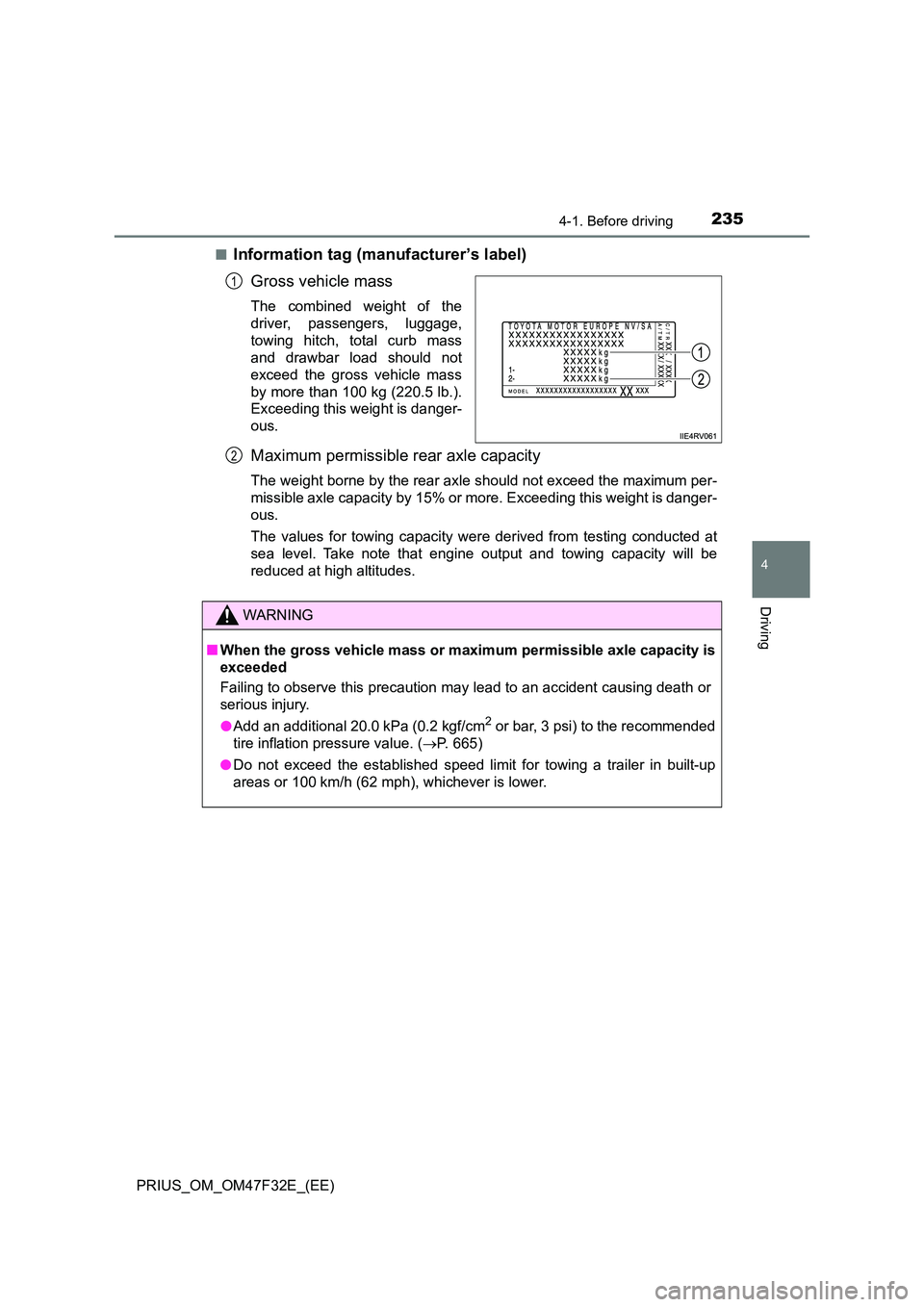
2354-1. Before driving
4
Driving
PRIUS_OM_OM47F32E_(EE)
■Information tag (manufacturer’s label)
Gross vehicle mass
The combined weight of the
driver, passengers, luggage,
towing hitch, total curb mass
and drawbar load should not
exceed the gross vehicle mass
by more than 100 kg (220.5 lb.).
Exceeding this weight is danger-
ous.
Maximum permissible rear axle capacity
The weight borne by the rear axle should not exceed the maximum per-
missible axle capacity by 15% or more. Exceeding this weight is danger-
ous.
The values for towing capacity were derived from testing conducted at
sea level. Take note that engine output and towing capacity will be
reduced at high altitudes.
1
2
WARNING
■ When the gross vehicle mass or maximum permissible axle capacity is
exceeded
Failing to observe this precaution may lead to an accident causing death or
serious injury.
● Add an additional 20.0 kPa (0.2 kgf/cm2 or bar, 3 psi) to the recommended
tire inflation pressure value. ( P. 665)
● Do not exceed the established speed limit for towing a trailer in built-up
areas or 100 km/h (62 mph), whichever is lower.
Page 240 of 770
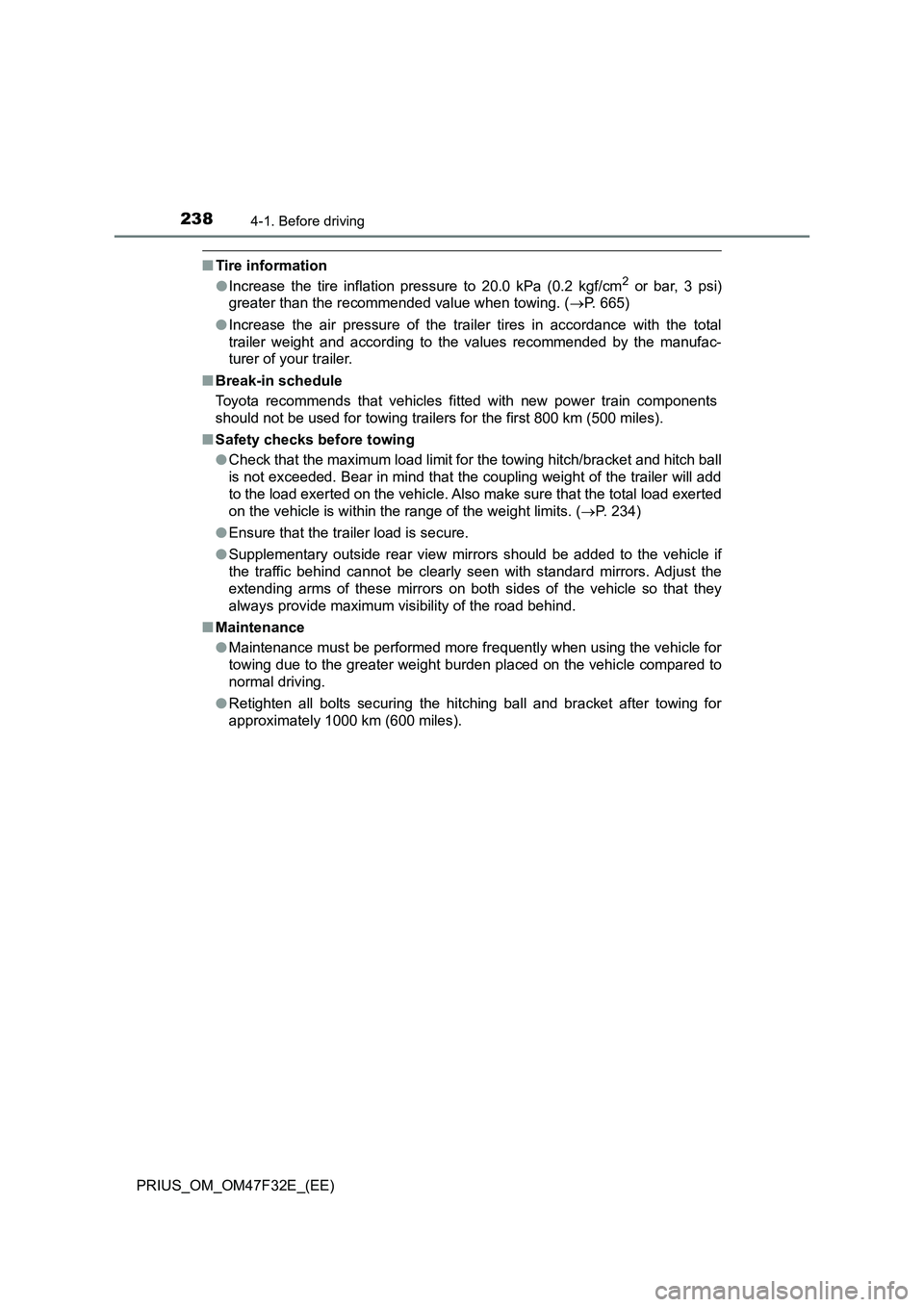
2384-1. Before driving
PRIUS_OM_OM47F32E_(EE)
■Tire information
●Increase the tire inflation pressure to 20.0 kPa (0.2 kgf/cm2 or bar, 3 psi)
greater than the recommended value when towing. (P. 665)
●Increase the air pressure of the trailer tires in accordance with the total
trailer weight and according to the values recommended by the manufac-
turer of your trailer.
■Break-in schedule
Toyota recommends that vehicles fitted with new power train components
should not be used for towing trailers for the first 800 km (500 miles).
■Safety checks before towing
●Check that the maximum load limit for the towing hitch/bracket and hitch ball
is not exceeded. Bear in mind that the coupling weight of the trailer will add
to the load exerted on the vehicle. Also make sure that the total load exerted
on the vehicle is within the range of the weight limits. (P. 234)
●Ensure that the trailer load is secure.
●Supplementary outside rear view mirrors should be added to the vehicle if
the traffic behind cannot be clearly seen with standard mirrors. Adjust the
extending arms of these mirrors on both sides of the vehicle so that they
always provide maximum visibility of the road behind.
■Maintenance
●Maintenance must be performed more frequently when using the vehicle for
towing due to the greater weight burden placed on the vehicle compared to
normal driving.
●Retighten all bolts securing the hitching ball and bracket after towing for
approximately 1000 km (600 miles).
Page 244 of 770
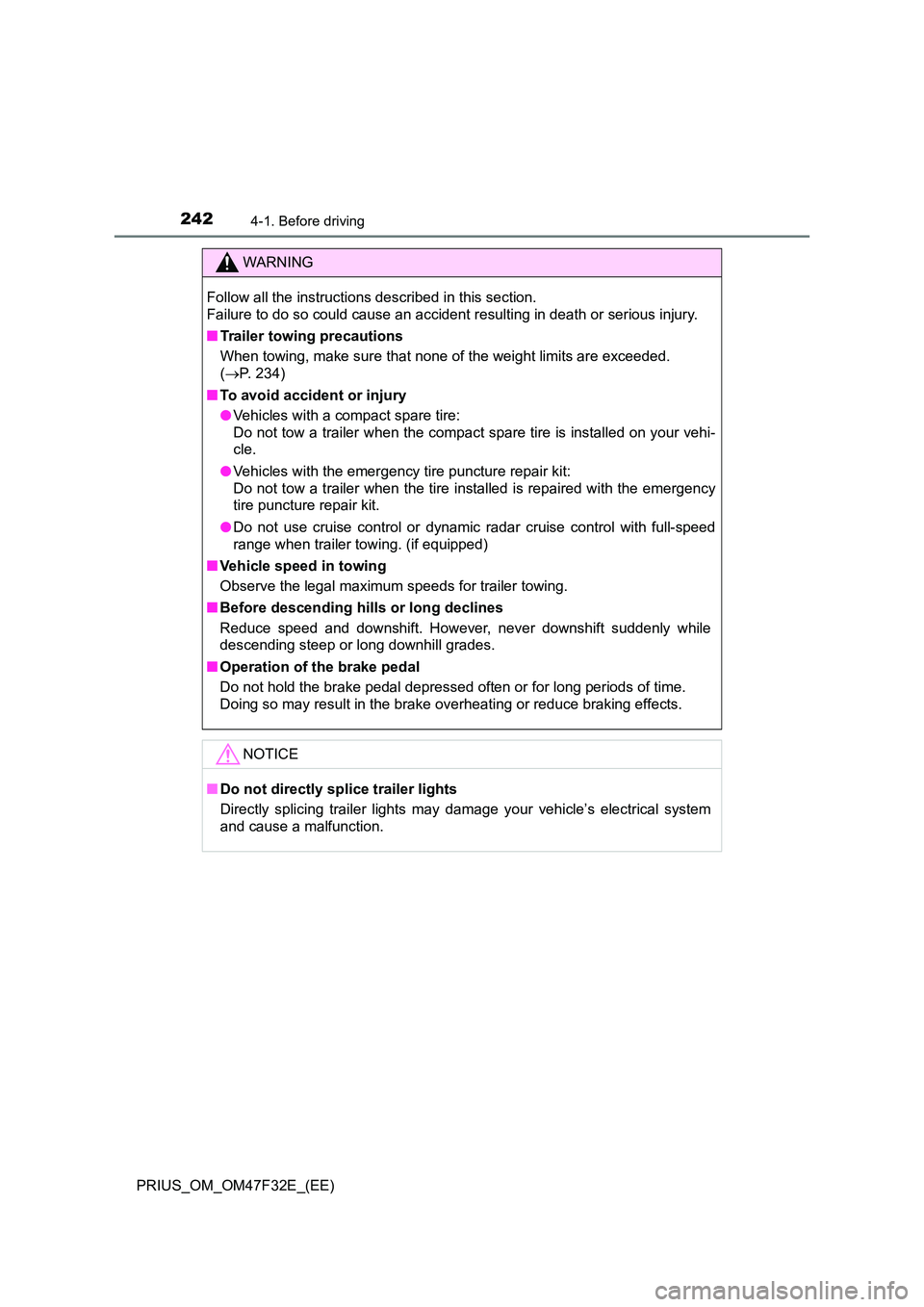
2424-1. Before driving
PRIUS_OM_OM47F32E_(EE)
WARNING
Follow all the instructions described in this section.
Failure to do so could cause an accident resulting in death or serious injury.
■ Trailer towing precautions
When towing, make sure that none of the weight limits are exceeded.
( P. 2 3 4 )
■ To avoid accident or injury
● Vehicles with a compact spare tire:
Do not tow a trailer when the compact spare tire is installed on your vehi-
cle.
● Vehicles with the emergency tire puncture repair kit:
Do not tow a trailer when the tire installed is repaired with the emergency
tire puncture repair kit.
● Do not use cruise control or dynamic radar cruise control with full-speed
range when trailer towing. (if equipped)
■ Vehicle speed in towing
Observe the legal maximum speeds for trailer towing.
■ Before descending hills or long declines
Reduce speed and downshift. However, never downshift suddenly while
descending steep or long downhill grades.
■ Operation of the brake pedal
Do not hold the brake pedal depressed often or for long periods of time.
Doing so may result in the brake overheating or reduce braking effects.
NOTICE
■ Do not directly splice trailer lights
Directly splicing trailer lights may damage your vehicle’s electrical system
and cause a malfunction.
Page 483 of 770
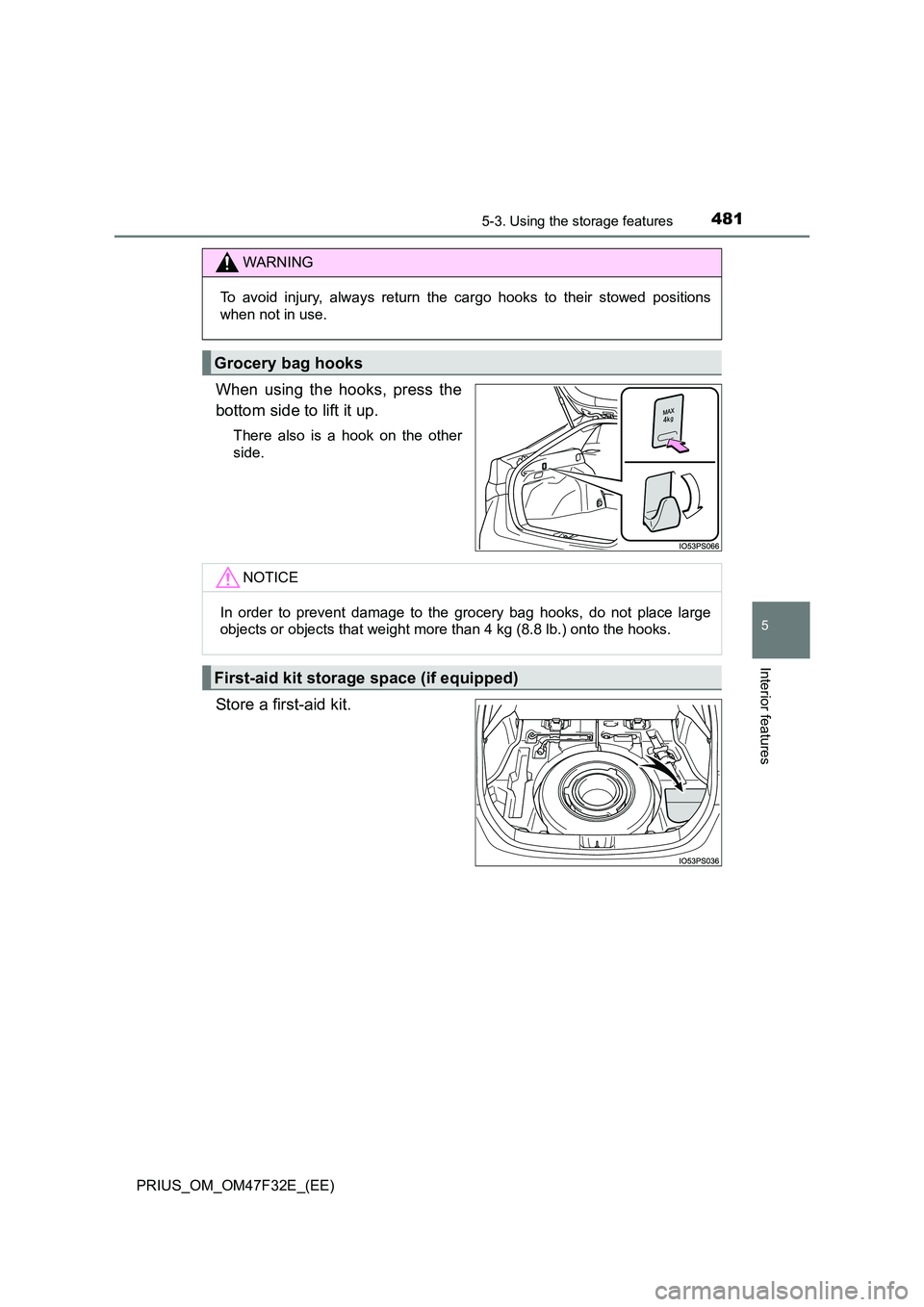
4815-3. Using the storage features
PRIUS_OM_OM47F32E_(EE)
5
Interior features
When using the hooks, press the
bottom side to lift it up.
There also is a hook on the other
side.
Store a first-aid kit.
WARNING
To avoid injury, always return the cargo hooks to their stowed positions
when not in use.
Grocery bag hooks
NOTICE
In order to prevent damage to the grocery bag hooks, do not place large
objects or objects that weight more than 4 kg (8.8 lb.) onto the hooks.
First-aid kit storage space (if equipped)